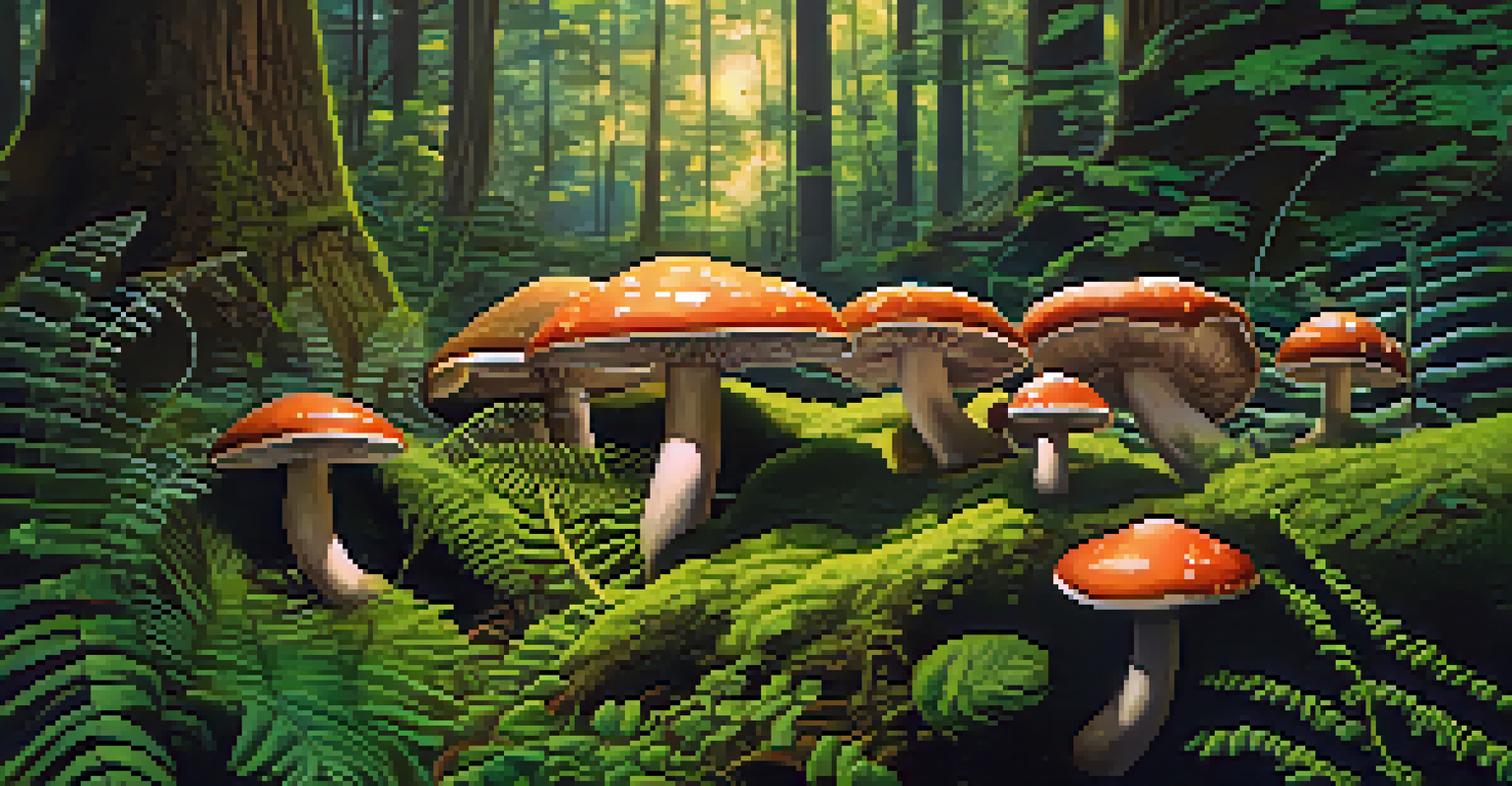The Evolution of Shamanic Practices: Entheogens Through Time

Understanding Shamanism: A Spiritual Framework
Shamanism is a spiritual practice that dates back thousands of years, often characterized by a shaman's ability to connect with the spirit world. This connection is typically sought for healing, guidance, and insight into the human experience. Through rituals and ceremonies, shamans facilitate a bridge between their community and the spiritual realm, emphasizing the importance of nature and the interconnectedness of all life.
Shamanism is not a religion, but a way of life, a way of perceiving the world and our connection to it.
In many cultures, shamanism also involves the use of entheogens—substances that induce altered states of consciousness. These powerful plants or fungi have been employed to enhance spiritual experiences, allowing practitioners to access deeper levels of understanding. By incorporating these entheogens, shamans can more effectively navigate their spiritual journeys and provide the necessary support for their communities.
As we delve deeper into the evolution of shamanic practices, we'll see how the use of entheogens has shaped these traditions over time, adapting to cultural shifts while maintaining their core principles. Understanding this evolution is crucial for appreciating the rich tapestry of human spirituality and the role entheogens have played within it.
Ancient Roots: Early Shamanic Practices
The origins of shamanism can be traced back to prehistoric times, where early humans sought to understand their environment and existence. Archaeological evidence suggests that our ancestors engaged in shamanic practices, often using entheogens found in nature to connect with the spiritual world. These early experiences laid the groundwork for the various shamanic traditions we see today.

For instance, evidence of cave paintings and artifacts indicates that ancient cultures utilized hallucinogenic plants like psilocybin mushrooms and peyote in their rituals. These practices not only provided insights into their lives but also fostered a sense of community and shared spirituality. The entheogens served as a catalyst for profound experiences that shaped their understanding of life, death, and the cosmos.
Shamanism Connects Us to Nature
Shamanism serves as a spiritual bridge between communities and the natural world, emphasizing the interconnectedness of all life.
As these early shamans developed their techniques and rituals, they began to pass down knowledge through generations, establishing a rich tradition that would evolve into the shamanic practices we recognize today. This oral history highlights the importance of entheogens in shaping cultural beliefs and practices around the world.
Cultural Variations: Shamanism in Different Societies
Shamanic practices vary significantly across cultures, each adapting to its unique environment and societal needs. For example, Siberian shamans often utilize the Amanita muscaria mushroom, while indigenous peoples in the Americas may turn to peyote or ayahuasca. These substances not only reflect the local flora but also embody the spiritual beliefs and practices of each culture.
The use of entheogens is a sacred tool for accessing the divine within us and the cosmos around us.
In many cases, the role of the shaman is deeply embedded in the community's social structure. For instance, in Amazonian cultures, shamans serve as healers and spiritual leaders, using entheogens like ayahuasca to facilitate healing and insight. This integration of entheogens into healing practices showcases the profound connection between spirituality and physical well-being.
Despite these variations, a common thread runs through many shamanic traditions—the belief in the transformative power of entheogens. This shared understanding speaks to the universal human quest for knowledge and connection, illustrating how these practices have evolved while retaining their core purpose across different cultures.
Modern Shamanism: Revival and Adaptation
In recent years, there has been a resurgence of interest in shamanic practices, particularly among those seeking alternative healing methods. This revival is often accompanied by a growing appreciation for the use of entheogens in therapeutic contexts. Many people are drawn to the idea of accessing altered states of consciousness for personal growth, healing, and spiritual exploration.
Modern shamans and practitioners often blend traditional techniques with contemporary practices, creating a unique fusion that resonates with today's seekers. This adaptation allows for a more inclusive approach, inviting individuals from various backgrounds to explore shamanic traditions and their potential benefits. Workshops, retreats, and online resources have made these practices more accessible than ever.
Entheogens Enhance Spiritual Practices
The use of entheogens like psilocybin and ayahuasca plays a crucial role in shamanic traditions, facilitating deeper spiritual experiences and healing.
However, it's essential to approach modern shamanism with respect and understanding, honoring the traditions from which these practices stem. By doing so, we can ensure that the wisdom of ancient practices continues to thrive in a way that is both respectful and relevant to contemporary society.
The Science of Entheogens: Bridging Spirituality and Science
As interest in entheogens grows, so too does the scientific exploration of their effects. Research has shown that substances like psilocybin and ayahuasca can promote profound psychological healing and personal insight. This growing body of evidence is bridging the gap between spirituality and science, providing a greater understanding of how these substances can impact the human experience.
Studies have indicated that entheogens can lead to significant changes in mood, perception, and overall mental health. For many, these experiences can be transformative, leading to a renewed sense of purpose and connection to self and others. The scientific community is beginning to acknowledge the potential benefits of entheogens, further legitimizing their place in healing practices.
This intersection of spirituality and science invites us to reconsider our understanding of consciousness and the human psyche. As we continue to explore the effects of entheogens, we may uncover deeper insights into the nature of reality and our place within it, fostering a greater appreciation for the ancient practices that have utilized these substances for millennia.
Challenges and Controversies: Navigating Modern Use
Despite the growing interest in entheogens, their use is not without challenges and controversies. Issues surrounding legality, safety, and cultural appropriation have emerged as entheogens gain popularity in modern society. It's crucial to navigate these concerns thoughtfully to ensure that these practices are conducted ethically and responsibly.
The legal status of many entheogens varies widely across countries, leading to confusion and potential misuse. As more people seek out these substances for personal growth, it is essential to understand the legal implications and potential risks involved. Education and responsible use are paramount in fostering a safe environment for exploration.
Modern Shamanism Faces Challenges
As interest in shamanic practices grows, issues of legality, safety, and cultural appropriation must be navigated thoughtfully to ensure ethical use.
Cultural appropriation is another significant concern, as individuals from outside indigenous communities may adopt these practices without understanding their cultural significance. It's vital to approach shamanic traditions with respect, acknowledging their origins and the people who have preserved them for generations. By fostering dialogue and education, we can work towards a more respectful and informed approach to modern shamanism.
The Future of Shamanic Practices and Entheogens
As we look to the future, the evolution of shamanic practices and the use of entheogens will likely continue to unfold. With ongoing scientific research and a growing interest in holistic healing, we may see a merging of ancient wisdom with modern therapeutic practices. This integration has the potential to enrich our understanding of spirituality and mental health.
Furthermore, as society becomes more open to exploring alternative healing methods, we may witness a broader acceptance of shamanic practices. This shift could lead to a greater appreciation for the role of spirituality in overall well-being, encouraging individuals to seek out these connections in their own lives. The future may hold exciting possibilities for those willing to explore the depths of their consciousness.

Ultimately, the journey of shamanic practices and entheogens is a reflection of humanity's quest for meaning and connection. By honoring the past while embracing the future, we can cultivate a deeper understanding of ourselves and the world around us, fostering a more harmonious existence.